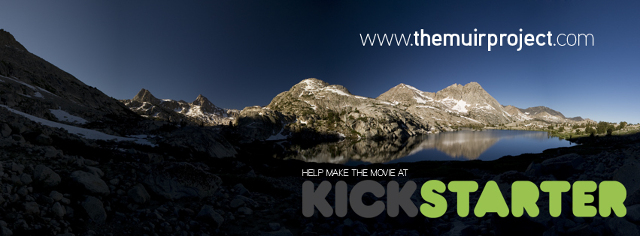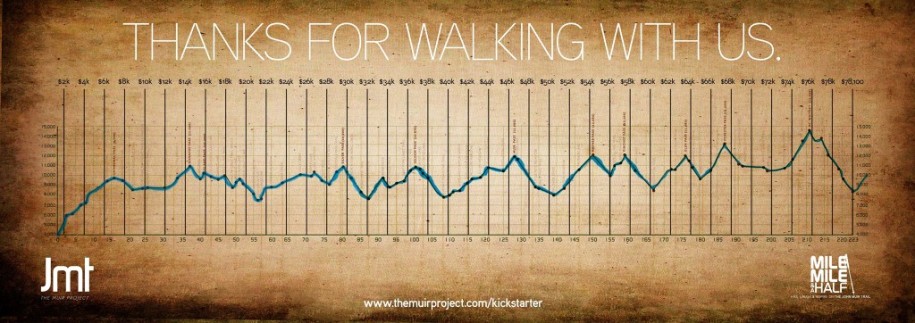Kickstarter: List of FOURS
15 Nov
We’ve been asked a lot of questions about our campaign, so we thought a Blog might be in order…
So before I get too far, I should answer that initial burning question: Why Kickstarter?
Well, we went this route for a few reasons:
1) The most obvious: It allowed us to raise the funds needed to finish the film and get it out the door.
2) It’s a great way to show there’s a viable audience for the film. We knew we’d be approaching sponsors and distributors, and this campaign proves we had an audience. This also allowed us (and forced us) to really concentrate on building the community that would appreciate the film.
3) We chose Kickstarter (as the crowd-funding platform) because we thought the notoriety of Kickstarter would allow us to raise our lofty goal, and as crazy as it sounds, we liked the “all or nothing” approach. In retrospect, I think I would have chosen IndieGogo, so we could have raised funds for a charity as well. You’ll see another reason under the “what we learned” section
4) All the cool kids are doing it.
Here are 4 DOs & DON’Ts We Learned from our Kickstarter Campaign.
DO:
1. DO Your research:
• Learn about all of Kickstarter’s Rules. We wanted to donate to a charity, but that’s not allowed. We built a fun calendar with giveaways. Again, a “no go.” It’d be a shame to do all the work and then have your project removed for poor planning.
• A strategy that worked for us: Mirror another Project. Choose another project (or several) that have similar sensibilities to yours and really watch what happens for them – reactions from fans, how they interact, their rewards, results, etc.
• Google Search other articles like this one. You might learn another bit of information that’ll make your life a little easier after the launch. Better to know now than once it’s too late.
2. DO Keep a Calendar.
•Before the Campaign Make sure that your calendar includes everything you’ll need before the campaign starts. Will you show samples of the rewards? Do you need anything else ready to go before you launch? We were scrambling just before our launch because Amazon had trouble linking our bank account, but didn’t inform us of this issue until several calls later.
•Every Day we scheduled everything from Updates to Thank Yous to everything happening outside of the Kickstarter platform. This helped us to remain on top of everything and keep our fans (and us) motivated the entire time.
3. DO Make a Budget: You’ve got one for your project, and you should have one for this too. Yes, it’s difficult to guess which rewards will get the most play, but knowing the out of pocket costs and your profit for each is very important. And don’t forget to calculate Kickstarter & Amazon’s fees and fees for packaging & sending rewards as well. (We chose to set $15 as the first level we would mail, and that was for something that would fit in a #10 envelope.)
4. DO Thank People & Keep Them Informed.
• We were nervous that people would tire of our updates. (We posted every 2-3 days.) But we also made sure that posts really had something to say – revealing new info, additional footage and sneak peeks, thanks and a call to action – they weren’t just a call for $.
• THANK EVERYONE. We took turns every night thanking our new backers, and we thought it’d be nice for them and the right thing to do. But the truth is, doing al the updates, reminders, posts and all during the day, WE needed that time to remember that people were taking the time to give their hard-earned money to be part of our project, and thanking them for that was incredibly uplifting.
DON’T
1. DON’T Give Up.
• There were times when we wondered “is this really worth it?” and “we’re not going to make it!” We started our campaign ahead of goal, but the last 5 days, we still needed to raise $8,000 to meet our goal. Talk about tense! But true to statistics from other campaigns, tons of pledges came in right at the end (and we ended up over goal.)
• There will be nay-sayers. No matter how wonderful and altruistic you intend to be, someone will say your project sucks, that they could do it better, and may even call you a liar. It really hit us hard when it happened for us on one blogosphere, and even though we had such incredible responses hundreds of times over, that one piece nagged at us. We chose to stay positive, not engage the person and we luckily had a Backer that was our voice and gave a positive position. All we could do was make sure that we are honest and true to the project, our followers and ourselves.
2. DON’T Set Your Goal Too High. Our initial goal was closer to $100,000. And although we’ll be spending that higher amount (and more) before it’s all said and done, we decided to go bare bones to hit our goal, finish the film and show a success. We also knew we had a film that wasn’t high drama and had no celebrities attached. Best to keep the budgets low, right?
3. DON’T Keep the Conversation Just on Kickstarter. We posted more than six times a day on Facebook. We kept up our own web blog, wrote numerous guest blog posts and fielded interviews from bloggers. We tweeted and pinned on Pinterest. We held live events and sent newsletters out to followers. We made friends with companies with high followers on Facebook so we could do cross-promotions. (Making friends is much easier than you think, as so many companies are hungry for content – especially on social media.) And this community is still part of our project today, even though we’ve pulled back on the number of times we reach out to them.
DON’T Go It Alone. Because we had five of us working on the project, we were able to have new voices telling the story (and asking for support.) Trust me, you WILL want help with this. From coming up with fun rewards that actually provide revenue, to updates, thanks, conversations on other platforms and ultimately reward fulfillment – having a team you can rely on makes all the difference in the world.
4. DON’T Go It Alone. Because we had five of us working on the project, we were able to have new voices telling the story (and asking for support.) Trust me, you WILL want help with this. From coming up with fun rewards that actually provide revenue, to updates, thanks, conversations on other platforms and ultimately reward fulfillment – having a team you can rely on makes all the difference in the world.
4 More Things we learned (without Kickstarter’s help)
1. It Takes a Village Or more to the point, you need to already have a village in place. Yes, more people will find your project than your initial group, but don’t count on that being the majority. The actual Backers coming in straight from Kickstarter were less than 4%. We brought the rest there.
2. Hello Crazy Person. I hate to inform you, but this will probably be you the second you hit “Launch” on your campaign. You WILL be checking your progress every second like some sort of addict, praying that people back it. And if you’re doing well, wondering just how well you could do and inventing grand schemes of how you can thank people for helping you raise $1 million. And yes, you will probably also haunt Kicktraq – which never helped determine how well we were be doing, it just gave us another way to agonize about the campaign and feel with “certainty” that we’d make it above and beyond goal or fail miserably, depending upon the updated feed.
3. You CAN change things after the campaign has started. But not everything. A Kickstarter staff member suggested we lower our prices, and we did. But the higher tiers that people had initially chosen still remained, and became a constant question for new Backers. Not until every Backer from that former tier had changed levels on their own, could we remove the old tier. Some were never removed.
4. That money goes fast. $77k (the amount we received from $85k after Kickstarter and Amazon took their cut) was handily spent on everything we detailed in the campaign’s overview. So much money, and yet it doesn’t even cover our initial investments. Ah well, I guess that’s why they call it a labor of love. Which leads to this point: Make sure YOU Believe in your project. If you don’t… how can anyone else?
A special thanks to our 814 Backers for their support of the campaign, The Muir Project and our documentary film, Mile… Mile & A Half.

